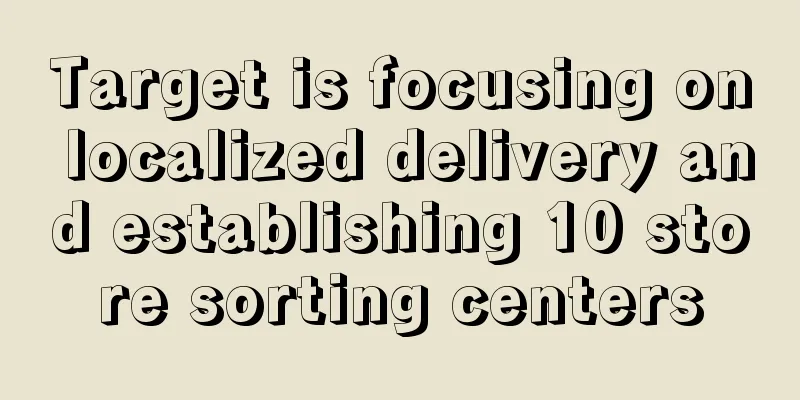Target is focusing on localized delivery and establishing 10 store sorting centers

|
On Friday, September 8, Target shared its progress in logistics infrastructure by adding more store sorting centers. As of September 1, Target already has 10 sorting centers, the first of which was piloted in Minneapolis in 2020, and in August, Target opened its latest sorting center in Miami.
Target said that these store sorting centers can increase delivery speed, reduce transportation costs, and help drive Target 's long-term growth plan, and it will continue to advance the "store as sorting center" strategy. Currently, Target picks up packages from 30 to 40 local stores every day (depending on the market), then takes them to local sorting centers for batch processing, and finally third-party carriers or Shipt for the last mile delivery.
At the second quarter earnings conference on August 16, Target Chief Operating Officer John Mulligan said that the opening of sorting centers is an important part of the omni-channel strategy, and the new sorting centers have improved the speed and efficiency of last-mile delivery. According to him, since these sorting centers have eliminated the sorting and packaging processes, the number of next-day delivery orders has increased by more than 150% since the sorting centers began operating.
According to Mulligan, in markets with sorting centers, package delivery time is nearly 1.5 days shorter than the average, and about one-third of packages can be delivered within one day. It is reported that Target will continue to open new store sorting centers and further iterate its operating model, and logistics indicators such as speed will continue to improve in the future.
In February this year, Target announced an investment of US$100 million to expand its sorting center network, with the goal of having more than 15 sorting centers by the end of 2026. When the investment expansion was announced, Target had already established 9 sorting centers in several states in the United States.
Currently, Target has 10 sorting centers. Mulligan said that by 2023, these 10 sorting centers are expected to handle more than 35 million packages, a year-on-year increase of more than 20% and more than six times that of 2021.
At this stage, Target is paying more attention to store sorting centers. At the same time, large retailers such as Amazon and Walmart are also increasing their investment in localized distribution, including using physical store networks to deliver e-commerce orders.
In fact, Target announced a larger plan in February, of which the expansion of the sorting center is just part. This major plan, aimed at driving growth and providing a more differentiated consumer experience, includes an investment of $4 billion to $5 billion in consumer-facing services, store networks, and supply chain facilities and services.
In addition, Target is building more facilities to further speed up delivery. In June, Target opened its first last-mile delivery facility in Smyrna, Georgia, which is responsible for receiving and warehousing local pre-sorted packages from the Atlanta sorting center, and Shipt drivers pick up and deliver them the next day.
Friday's announcement noted that as of now, all of Target's sorting centers have launched last-mile delivery facilities in partnership with Shipt. 40% of orders delivered by Shipt drivers for the last mile are able to be delivered the next day. As the last-mile delivery network expands, Target plans to further expand the scale of next-day delivery.
Mulligan said at the earnings conference that 70% of the packages handled by these sorting centers are delivered in the local market where the sorting center is located. Since Target acquired Shipt in 2017, the cooperation between the two has brought efficiency improvements, cost reductions, and increased delivery speed.
Since this year, Target has also provided drivers with the option of larger capacity trucks to handle larger freight volumes, with each vehicle able to carry up to eight times more packages than the original vehicle. In fact, as early as 2022, Target and Shipt conducted a test of using large-capacity trucks for transportation.
Target is currently testing high-capacity truck deliveries in two sortation center markets and plans to expand high-capacity truck deliveries to all markets in the coming years. Editor✎ Ashley/ Disclaimer: This article is copyrighted and may not be reproduced without permission. |
>>: Seize the Amazon market! What is the focus of Walmart's e-commerce expansion?
Recommend
What is Walker Extraordinary? Walker Extraordinary Review
WOOK (Shenzhen WOOK Technology Co., Ltd.) is a mob...
Back-to-school season strategy: What products are selling well?
Summer is almost over and back-to-school shopping ...
How can Amazon sellers create a high-quality review?
1. Quickly post direct reviews The so-called dire...
New FBA plan for next year! These fees can be waived!
The beginning of the year is a good time for ever...
What is Ever Marker? Ever Marker Review
Ever Marker (EveRMArker), also known as "Wans...
Sellers, beware! An American buyer used an Amazon return loophole to defraud over $300,000!
According to the U.S. Department of Justice, 34-ye...
BNPL demand slows! Affirm lays off 19% of staff after announcing losses
It is learned that on February 9, Affirm, a buy no...
Starting from scratch, Shopify sellers’ entrepreneurial stories series ③: Opening a store on Shopify and earning the first pot of gold
[Editor's Note] Sellers, do you want to know ...
Is the cross-border industry ushering in a new trend? Top domestic platforms are reported to be entering the cross-border industry
Recently, a new big opportunity is coming to the c...
How to refine product selling points? Ideas for deep listing optimization
Simply speaking, writing a listing is about descr...
50,000 Chinese sellers on Amazon were “taken down”. How can China’s cross-border business make a strong comeback in the future?
The epidemic has caused a huge upheaval in the cro...
Selling 20,000 units a month? Why is Anker planning for green and sustainable growth?
Trump promoted the domestic brand Anker power bank...
What is Laiyi Media? Laiyi Media Review
Lyeea-Media was founded in Los Angeles, USA in 201...
What is rail transport? Rail transport review
Railway transportation (train transportation) refe...
How to properly direct traffic to Amazon?
1. Focus on the site, supplemented by external si...









